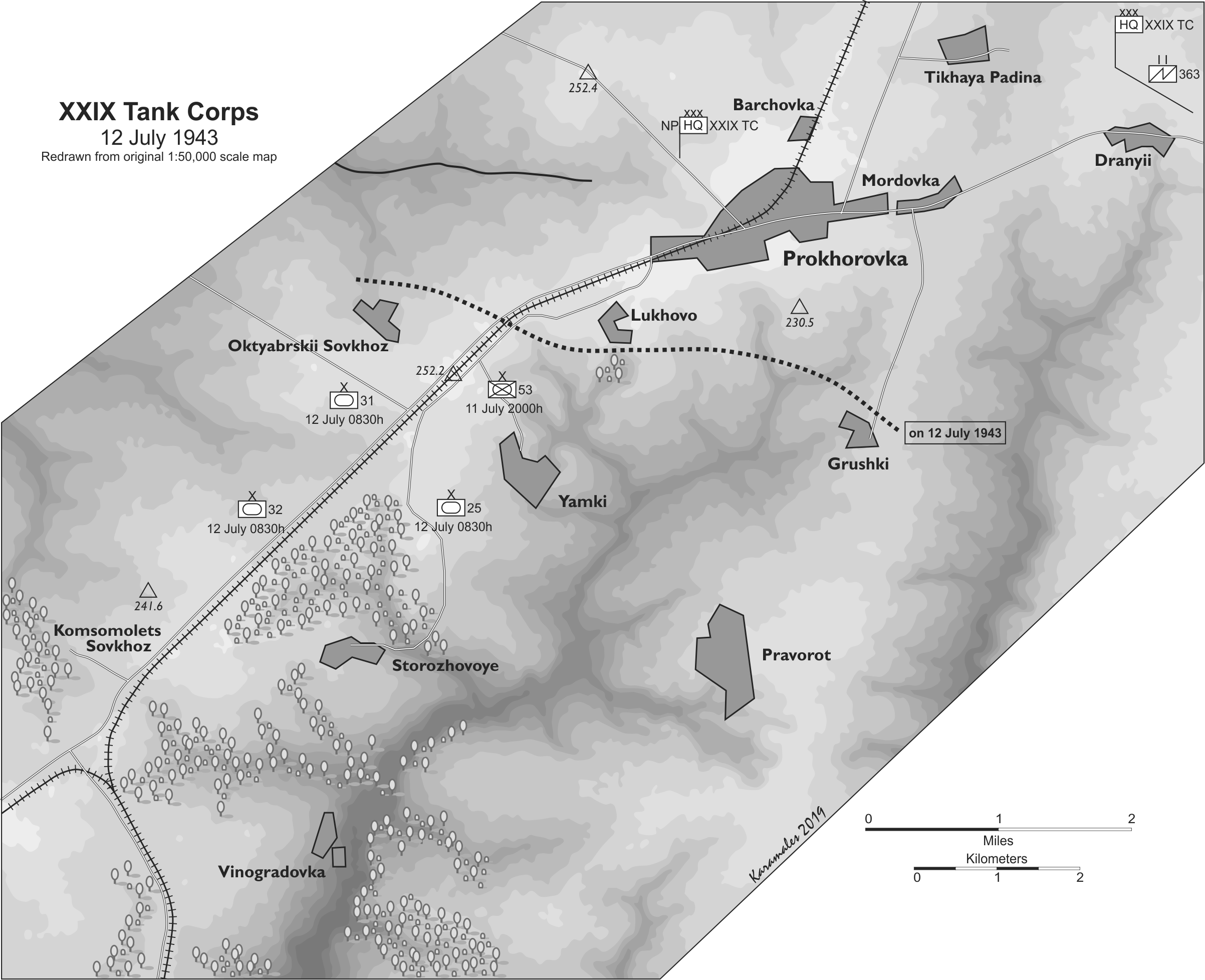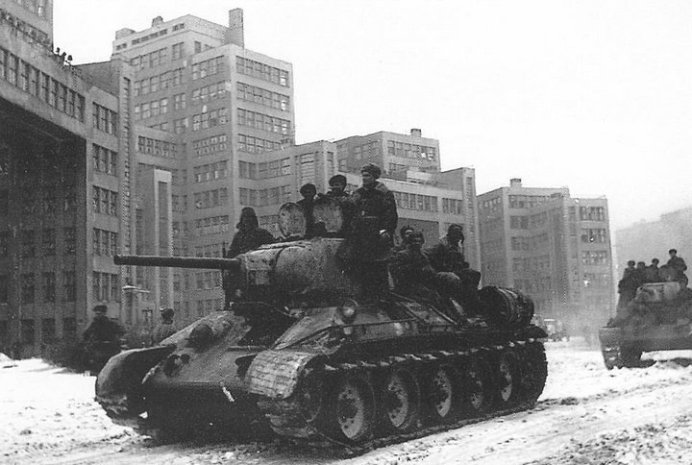
Dr. Wheatley requested me to list out the losses for the 32nd and 31st Tank Brigades on 12 July 1943. They were the two attacking tank brigades on the right flank of the XXIX Tank Corps, with the 32nd Tank Brigade in the first echelon and the 31st in the second echelon. Next to the 32nd Tank Brigade was the 25th Tank Brigade and they were supported by the 53rd Motorized Rifle Brigade. Here are their reports (the text in italics are the direct translations of the reports, done by Dr. Richard Harrison):
Operational Report #90, 0800 July 11, 1943. HQ 29th TC:
Corps material and supply situation:
25th TBde: 32 T-34s, 39 T-70s, 103 cars, 4 45mm guns, 3 37mm guns, 6 82mm mortars
31st TBde: 31 T-34s, 39 T-70s, 103 cars, 4 45mm guns, 2 37mm guns, 6 82mm mortars
32nd TBde: 63-T34s, 102 cars, 4 45mm guns, 2 25mm guns, and 6 82mm mortars
53rd MotRBde: 293 cars, 17 BA-64 armored cars, 12 76mm guns, 12 45mm guns, 30 82mm mortars and 6 120mm mortars.
271st Mortar Rgt: 69 cars and 36 120mm mortars
1446th Self-Propelled ArtRgt: 28 cars, 9 76mm SP guns, 12 122mm howitzers
108th ATArtRgt: 37 cars, 12 76mm guns and 8 45mm guns
75th Motorcycle Bn: 10 BA-64s, 13 cars, 72 motorcycles, and 4 82mm mortars
38th Armored Bn: 7 T-70s, 12 BA-10s, 10 BA-64s and 12 cars
363rd Ind Communications Bn: 74 cars, 10 BA-64s, and 3 T-34s.
193rd Sapper Bn: 31 cars
69th (?) Reconnaissance Bn: 15 cars
72nd (?) Reconnaissance Bn: 10 cars
1st (?) Co: 45 cars
7th (?): 6 cars
Combat Report #73, 1600, July 11, 1943, HQ: 29th TC:
Type……………………….25th TBde…..31st TBde…..32nd TBde…..1446th SP Art Rgt
T-34…………………………31………………29……………….60………………-
T-34 (in repair)…………..1……………….3…………………..4……………….-
T-70………………………..36……………….38………………..-………………..-
T-70 (in repair)…………..3………………..1…………………-…………………-
KV……………………………1………………………………………………………..-
122mm SAU………………1……………………………………………………….11
76mm SAU………………..1………………………………………………………….8
Corps Strength 123 T-34s, 81 T-70s, 11 122mm SAUs, and 8 76mm SAU.
Note that this Corps Strength list does not match the list above in any category. In part because there were 7 T-70s with the 38th Armored Bn and 3 T-34s with the 363rd Ind Communications Bn.
Combat Report #75, 2400, July 12, 1943, HQ 29th TC:
25th Tank Brigade losses: 140 men killed, 180 wounded. 13 T-34s and 10 T-70s were irretrievably lost; 11 T-34s and 10 T-70s were knocked out or hit mines; 7 T-34s and 4 T-70s are out of action due to technical breakdowns.
32nd Tank Brigade losses: 100 men killed and 130 wounded. Overall, 54 T-34s were either burned, knocked out, or are in need of repair.
31st Tank Brigade losses: 20 T-34s and 18 T-70s knocked out and burned. Tanks in line: 3, with the location and condition of the remainder being investigated.
During the night 3 T-34s and 1 122mm SAU were repaired.
The evacuation of knocked-out tanks is being carried out by 3 turretless T-34s and a single M-3 “Grant”. Four brigades are working to restore damaged equipment, with one working to repair self-propelled guns; 2 brigades working to repair 32nd TBdes equipment, and 1 working for 31st TBde.
Note the reference to evacuation of tanks, which does have some definite impact on the photo reconnaissance pictures taken on 16 July and 7 August 1943.
Operational Report #2, 0700, July 13, 1943. HQ 5th Gds Tank Army:
29th TC: Losses: 95 T-34s, 38 T-70s, 8 self-propelled platforms, 240 men killed and 610 wounded.
Combat Report #76, 1300, July 13, 1943, HQ 29th TC:
31st Tank Bde: Material Supply and condition: 8 T-34s and 20 T-70s in line; during the night 8 T-34s were evacuated from the field.
Losses for 12 July: 14 men killed, 27 wounded, and 15 missing. 1 45mm guns wrecked, 1 heavy MG, 2 SMGs and 1 rifle.
25th Tank Bde, consisting of 50th MotRBn, 11 T-70s and 2 guns from an antitank battalion, are defending 1 km east of Storzhevoye.
32nd Tk Bde: Tanks in line: 12 T-34s
1529th Self-Propelled Art Rgt is in Prokhorovka.
Operational Report #91, 0400 July 14, 1943. HQ 29th TC:
25th TBde losses: 40 men killed, 87 wounded, 2 T-70s burns, and 1 knocked out.
53rd MotRBde: Losses for July 12: 517 men killed and missing, and 572 wounded; 16 heavy MGS, 25 AT rifles, 2 45mm guns, 13 light MGs, and 2 cars.
1446th Self-Propelled ArtRgt turned over 2 guns to 25th TBde and 6 to 32nd TBde. Losses for July 12: 19 men killed, 14 wounded; 8 122mm SAUs and 3 76mm SAUs destroyed.
108th ATArtRgt is the corps commander’s reserve without losses
271st Mortar Rgt has been subordinated to 53rd MotRBde. Losses for July 12: 5 men killed and missing, with 4 wounded.
On July 12 1 man was killed and another wounded.
Material Condition:
On hand: 31 T-34s, 40 T-70s, 3 122mm SAUs, and 5 76mm SAUs
Losses: 58 T-34s, 23 T-70s, 8 122mm SAUs, and 3 76mm SAUs
Undetermined location: 18 T-34s and 9 T-70s
Needing major repairs: 11 T-34s and 5 T-70s
Needing lesser repairs: 13 T-34s and 8 T-70s
Operational Report #4, 0700, July 14, 1943. HQ 5th Gds Tank Army:
29th TC: Losses: 3 T-70s, of which 2 were irreplaceable; 40 men killed and 87 wounded. Tanks on hand: 31 T-34s, 40 T-70s.
Operational Report #92, 1600 July 14, 1943. HQ 29th TC:
25th TBde losses: 1 T-70 burns, 1 man killed and 5 wounded.
Equipment Strength:
On hand: 33 T-34s, 39 T-70s, 3 122mm SAUs, and 5 76mm SAUs.
Combat Report #77, 1900, July 14, 1943. HQ 29th TC:
25th TBde: Losses 1 T-70 burned, 1 man killed and 5 wounded.
Operational Report #5, 1900, July 14, 1943. HQ 5th Gds Tank Army:
29th TC: Losses: 1 T-70 burned, 1 man killed and 5 wounded. Tanks on hand: 33 T-34s and 39 T-70s.
Operational Report #6, 0700, July 15, 1943. HQ 5th Gds Tank Army:
29th TC: Tanks in line: 35 T-34s and 40 T-70s
Operational Report #94, 1600 July 15, 1943. HQ 29th TC:
31st TBde: Tanks on hand: 15 T-34s and 20 T-70s. Losses: 1 man killed.
53rd MotRBde: Losses 1 man killed, 17 wounded.
25th TBde: Tanks on hand: 5 T-34s and 19 T-70s. Loses: 1 T-70 knocked out, 1 man killed.
32nd TBde: Tanks on hand: 15 T-34s.
Operational Report #7, 0400, July 16, 1943. HQ 5th Gds Tank Army:
29th TC: Losses: 1 T-70 knocked out, 1 man killed. Tanks in line: 40 T-34s and 45 T-70s.
Combat Report #80, 1900 July 16, 1943 HQ 29th TC:
25th TBde: Losses: none. Material Status: 5 T-34s and 17 T-70s in the line; 4 antitank guns; 5 82mm mortars; 3 37mm AA guns.
31st TBde: Material Status: 16 T-34s and 21 T-70s in the line; 3 45mm guns, 2 37mm guns, 2 MBGs, and 3 82mm guns [probably mortars]
32nd TBde: Losses for July 16: 5 men killed, 5 wounded, 1 T-34. Enemy aircraft, in groups of up to 60 planes, bombed the brigade’s positions 4 times.
One notes that in most wargames, attacking a tank brigade with 120 or more Ju-87s and Fw-190s would probably result in more than 13 casualties (see below).
53rd MotRBde: Losses 2 men wounded. Material status: 11 76mm guns; 7 45mm guns; 51 AT rifles; 19 HMGs, 41 LMGs.
1446th Self-Propelled ArtRgt: Equipment on hand: 4 122mm SAUs and 6 76mm SAUs.
271st Mortar Rgt: Losses: 3 men wounded due to bombing and 3 cars damaged. Material condition: 33 120mm mortars.
108th ATArtRgt: Material status: 12 76mm and 8 45mm guns.
38th Armored Bn: Material status: 7 T-70s, 12 Ba-10s and 10 Ba-64s.
75th Motorcycle Bn: 9 BA-64s and 60 motorcycles.
Operational Report #95, 2400 July 16, 1943. HQ 29th TC:
Losses for July 16: 6 men killed and 19 wounded, 1 T-34, 3 cars knocked out and 3 damaged.’
Material Condition: 42 T-34s, 47 T-70s, 1 KV, 4 122mm SAUs, 6 76mm SAUs, 23 76mm guns, 26 45mm guns, 5 37mm guns, 3 25mm guns, 39 120mm mortars, 44 82mm mortars. By 0600 on July 17 5 T-34s and 3 T-70s will be restored.
Operational Report #96, 2400 July 16, 1943. HQ 29th TC:
Material Status: 42 T-34s, 50 T-70s, 1 KV, 4 122mm SAUs, 6 76mm SAUs, 23 76mm guns, 26 45mm guns, 5 47mm guns, 3 25mm guns, and 44 82mm mortars.
Operational Report #8, 0400, July 17, 1943. HQ 5th Gds Tank Army:
29th TC: Losses: 1 T-34, 5 men killed and 10 wounded. 6 cars smashed or knocked out. Tanks in line: 39 T-34s and 45 T-70s.
XXIX Tank Corps (Fond 332, Opis: 1943, Delo: 80, Pages 2-3):
Information on Equipment Loses and Strengths, July 12-16
Equipment Strength: July 12-16
T-34s: 56
T-70: 52
KV: 1
SU-122: 4
SU-76: 6
Irreplaceable loses (burned)
T-34: 60
T-70: 31
SU-122: 8
SU-76: 3
Transportation Equipment Strength
1.5 tons: 572
2.5-3 tons: 205
Irreplaceable Losses:
1.5 tons: 15
2.5-3 tons: 8
Jeeps: 2
Artillery Strength:
76mm: 23
45mm: 26
37mm AA: 5
25mm AA: 3
120mm Mortar: 39
82mm Mortar: 44
Irreplaceable Artillery Losses:
76mm gun: 1
45mm gun: 1
120mm mortar: 3
82mm mortar: 5
Readiness of Rifle Companies:
25th TBde: 50%
31st TBde: 55%
32nd TBde: 85%
53rd MotRBde: 40%
Note that I had to retype all these entries, and I am ham-fisted, so there might be typo or two in them.
By the way, reviewing this just reinforces my opinion that the 31st Tank Brigade was in a second echelon position and used as such. May not have ever gotten past Oktyabrskii Sovkhoz.





